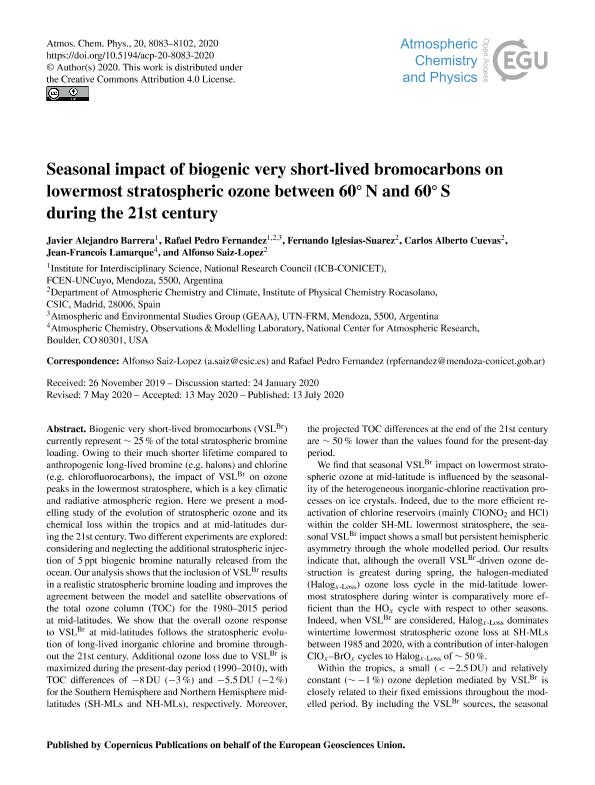Mostrar el registro sencillo del ítem
dc.contributor.author
Barrera, Javier Alejandro

dc.contributor.author
Fernandez, Rafael Pedro

dc.contributor.author
Iglesias Suarez, Fernando
dc.contributor.author
Cuevas, Carlos Alberto

dc.contributor.author
Lamarque, Jean Francois
dc.contributor.author
Saiz-lopez, Alfonso

dc.date.available
2021-09-08T18:14:29Z
dc.date.issued
2020-07
dc.identifier.citation
Barrera, Javier Alejandro; Fernandez, Rafael Pedro; Iglesias Suarez, Fernando; Cuevas, Carlos Alberto; Lamarque, Jean Francois; et al.; Seasonal impact of biogenic very short-lived bromocarbons on lowermost stratospheric ozone between 60° N and 60° S during the 21st century; Copernicus Publications; Atmospheric Chemistry and Physics; 20; 13; 7-2020; 8083-8102
dc.identifier.uri
http://hdl.handle.net/11336/139925
dc.description.abstract
Biogenic very short-lived bromocarbons (VSLBr) currently represent ∼25 % of the total stratospheric bromine loading. Owing to their much shorter lifetime compared to anthropogenic long-lived bromine (e.g. halons) and chlorine (e.g. chlorofluorocarbons), the impact of VSLBr on ozone peaks in the lowermost stratosphere, which is a key climatic and radiative atmospheric region. Here we present a modelling study of the evolution of stratospheric ozone and its chemical loss within the tropics and at mid-latitudes during the 21st century. Two different experiments are explored: considering and neglecting the additional stratospheric injection of 5 ppt biogenic bromine naturally released from the ocean. Our analysis shows that the inclusion of VSLBr results in a realistic stratospheric bromine loading and improves the agreement between the model and satellite observations of the total ozone column (TOC) for the 1980?2015 period at mid-latitudes. We show that the overall ozone response to VSLBr at mid-latitudes follows the stratospheric evolution of long-lived inorganic chlorine and bromine throughout the 21st century. Additional ozone loss due to VSLBr is maximized during the present-day period (1990?2010), with TOC differences of −8 DU (−3 %) and −5.5 DU (−2 %) for the Southern Hemisphere and Northern Hemisphere mid-latitudes (SH-MLs and NH-MLs), respectively. Moreover, the projected TOC differences at the end of the 21st century are ∼50 % lower than the values found for the present-day period.We find that seasonal VSLBr impact on lowermost stratospheric ozone at mid-latitude is influenced by the seasonality of the heterogeneous inorganic-chlorine reactivation processes on ice crystals. Indeed, due to the more efficient reactivation of chlorine reservoirs (mainly ClONO2 and HCl) within the colder SH-ML lowermost stratosphere, the seasonal VSLBr impact shows a small but persistent hemispheric asymmetry through the whole modelled period. Our results indicate that, although the overall VSLBr-driven ozone destruction is greatest during spring, the halogen-mediated (Halogx-Loss) ozone loss cycle in the mid-latitude lowermost stratosphere during winter is comparatively more efficient than the HOx cycle with respect to other seasons. Indeed, when VSLBr are considered, Halogx-Loss dominates wintertime lowermost stratospheric ozone loss at SH-MLs between 1985 and 2020, with a contribution of inter-halogen ClOx?BrOx cycles to Halogx-Loss of ∼50 %.Within the tropics, a small (<−2.5 DU) and relatively constant (∼−1 %) ozone depletion mediated by VSLBr is closely related to their fixed emissions throughout the modelled period. By including the VSLBr sources, the seasonal Halogx-Loss contribution to lowermost stratospheric ozone loss is practically dominated by the BrOx cycle, reflecting the low sensitivity of very short-lived (VSL) bromine to background halogen abundances to drive tropical stratospheric ozone depletion. We conclude that the link between biogenic bromine sources and seasonal changes in heterogeneous chlorine reactivation is a key feature for future projections of mid-latitude lowermost stratospheric ozone during the 21st century.
dc.format
application/pdf
dc.language.iso
eng
dc.publisher
Copernicus Publications

dc.rights
info:eu-repo/semantics/openAccess
dc.rights.uri
https://creativecommons.org/licenses/by-nc-sa/2.5/ar/
dc.subject
Very short lived
dc.subject
Bromine
dc.subject
Impact
dc.subject
Ozono
dc.subject
Tropics
dc.subject
Midlatitudes
dc.subject
Stratosphere
dc.subject
Very short lived
dc.subject.classification
Físico-Química, Ciencia de los Polímeros, Electroquímica

dc.subject.classification
Ciencias Químicas

dc.subject.classification
CIENCIAS NATURALES Y EXACTAS

dc.subject.classification
Meteorología y Ciencias Atmosféricas

dc.subject.classification
Ciencias de la Tierra y relacionadas con el Medio Ambiente

dc.subject.classification
CIENCIAS NATURALES Y EXACTAS

dc.subject.classification
Ingeniería Medioambiental y Geológica, Geotécnicas

dc.subject.classification
Ingeniería del Medio Ambiente

dc.subject.classification
INGENIERÍAS Y TECNOLOGÍAS

dc.title
Seasonal impact of biogenic very short-lived bromocarbons on lowermost stratospheric ozone between 60° N and 60° S during the 21st century
dc.type
info:eu-repo/semantics/article
dc.type
info:ar-repo/semantics/artículo
dc.type
info:eu-repo/semantics/publishedVersion
dc.date.updated
2021-08-25T19:28:40Z
dc.identifier.eissn
1680-7324
dc.journal.volume
20
dc.journal.number
13
dc.journal.pagination
8083-8102
dc.journal.pais
Alemania

dc.journal.ciudad
Gotinga
dc.description.fil
Fil: Barrera, Javier Alejandro. Consejo Nacional de Investigaciones Científicas y Técnicas. Centro Científico Tecnológico Conicet - Mendoza. Instituto Interdisciplinario de Ciencias Básicas. - Universidad Nacional de Cuyo. Instituto Interdisciplinario de Ciencias Básicas; Argentina
dc.description.fil
Fil: Fernandez, Rafael Pedro. Consejo Nacional de Investigaciones Científicas y Técnicas. Centro Científico Tecnológico Conicet - Mendoza. Instituto Interdisciplinario de Ciencias Básicas. - Universidad Nacional de Cuyo. Instituto Interdisciplinario de Ciencias Básicas; Argentina. Consejo Superior de Investigaciones Científicas; España. Universidad Tecnológica Nacional; Argentina
dc.description.fil
Fil: Iglesias Suarez, Fernando. Consejo Superior de Investigaciones Científicas; España
dc.description.fil
Fil: Cuevas, Carlos Alberto. Consejo Superior de Investigaciones Científicas; España
dc.description.fil
Fil: Lamarque, Jean Francois. National Center for Atmospheric Research; Estados Unidos
dc.description.fil
Fil: Saiz-lopez, Alfonso. Consejo Superior de Investigaciones Científicas; España
dc.journal.title
Atmospheric Chemistry and Physics
dc.relation.alternativeid
info:eu-repo/semantics/altIdentifier/url/https://www.atmos-chem-phys.net/20/8083/2020/
dc.relation.alternativeid
info:eu-repo/semantics/altIdentifier/doi/https://doi.org/10.5194/acp-20-8083-2020
Archivos asociados
